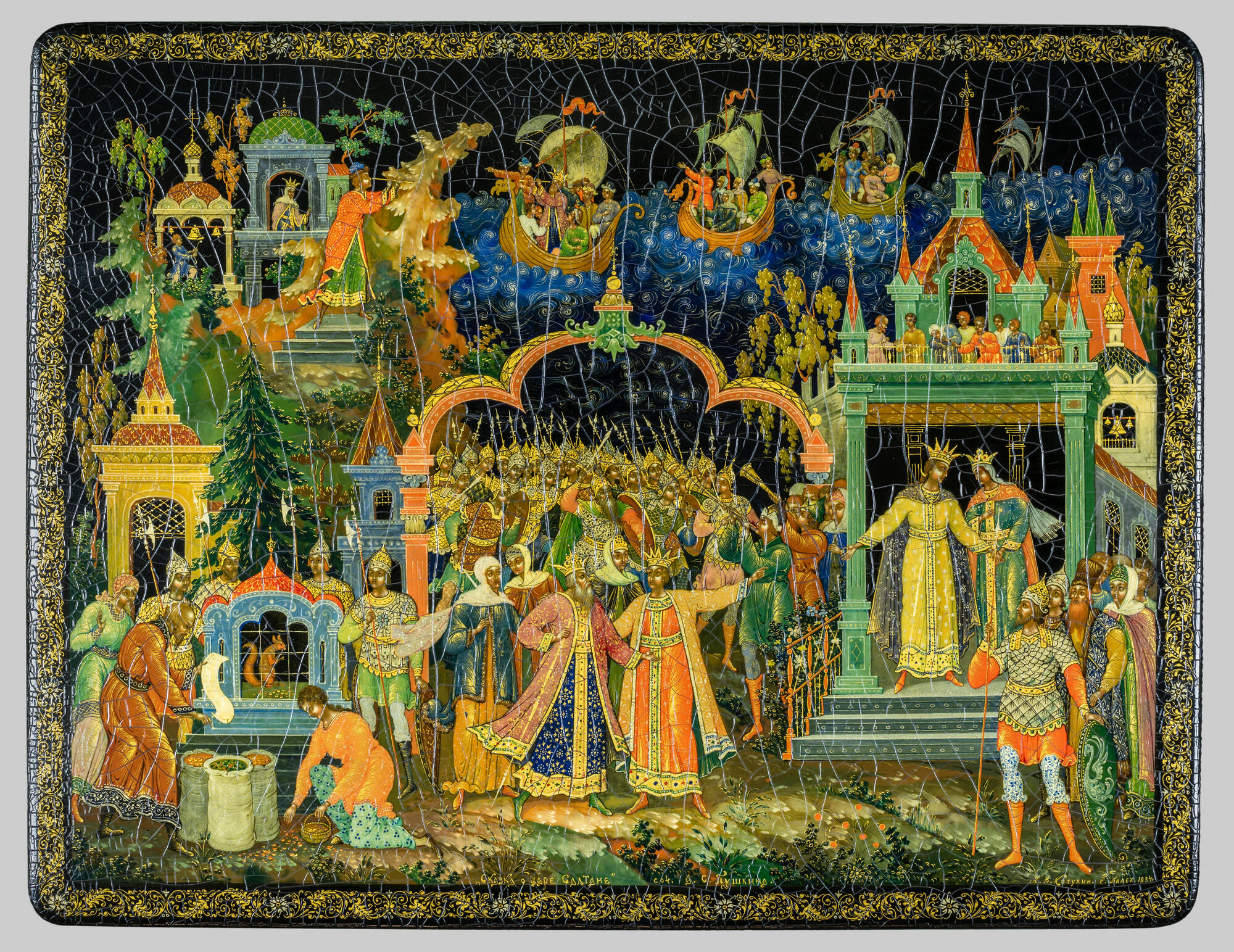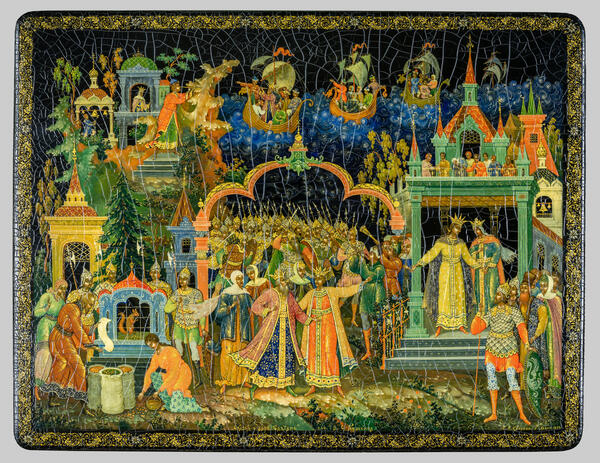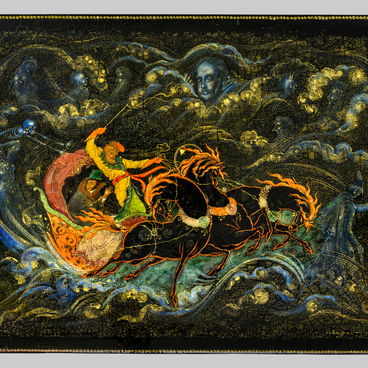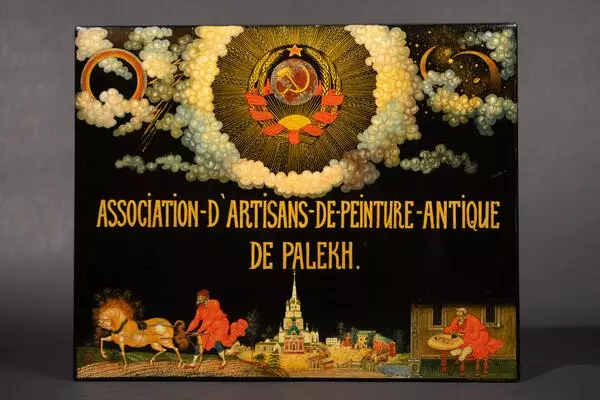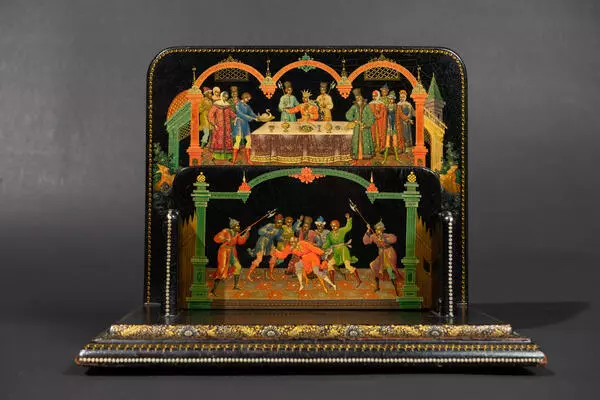Aleksandr Kotukhin created the casket ‘The Tale of Tsar Saltan’ in 1934.
Alexander Pushkin’s fairytale of the same includes the following lines of poetry: “Three fair maidens, late one night, sat and spun by candlelight”, and “There”s a little squirrel dwelling in a fir tree; all day long, cracking nuts, it sings a song'. The tale is sometimes quoted in casual conversation due to its immense popularity. Aleksandr Kotukhin, however, drew his inspiration not from Pushkin”s tale, but from the opera by Rimsky-Korsakov of the same name, which he saw in Bolshoy Theatre. Vibrant music, colorful costumes, and the lively plot have left a big impression on the artist from Palekh. He created a color-rich, spectacular artwork to match that opera impression.
The artist has painted the top of the item as well as its walls. The lid is the nexus of the composition. The artist has separated it into several distinct planes. In the background, the fleet of Tsar Saltan approaches the island, and prince Guidon is watching the ships from the top of a tall tower. The researchers often comment on the way the sea was painted in this scene. On the surface, it”s foaming with cyan and blue, and deep down below, it”s black. The waves curl into foamy patterned swooshes. The ever-changing element moves as if it was a living thing, even though the artist used conditional techniques to depict it.
In the foreground, the artist has painted several wonders at once: in the centre, 33 knights follow prince Guidon and Tsar Saltan; on the left, there is a squirrel with her emerald; on the right, the Swan Princess and the Tsaritsa are coming out of prince”s chambers. The scenes are connected by a three-bladed arch.
On the sides of the casket, the master has depicted the scene described by the initial lines of the tale. On the front wall, there are the “Three fair maidens” and “Saltan bids farewell to his wife” scenes. On the short wall, the reading of the Tsar’s decree is depicted. The subsequent scenes are on the long wall across from the short one: the fabled town is painted there, as well as the scene of Guidon saving the swan from the kite. The fourth wall shows the hero meeting the Swan Princess.
To further decorate his creation, the artist has added golden ornaments on heroes' clothes and lines of architecture. Gaps filled with silver and gold are also decorative elements in themselves: they aren’t really there to emphasize volume, but rather to create an intricate interwoven pattern. Vibrant colors and ornamentality are the signature traits of Aleksandr Kotukhin’s creative method.
The artist was born in 1886 and passed away in 1961. In the early days of his career in arts, he was training to be an icon painted at the Sofonov workshop for six years. Later he started painting the churches in Samara governorate, and then moved on to work in icon painting shops in the capital. After the October Revolution, he became one of the founders of the Artel of Ancient Painting and its first chairman. Due to his efforts manufacturing of semi-finished products from papier-mâché was started in Palekh.
Alexander Pushkin’s fairytale of the same includes the following lines of poetry: “Three fair maidens, late one night, sat and spun by candlelight”, and “There”s a little squirrel dwelling in a fir tree; all day long, cracking nuts, it sings a song'. The tale is sometimes quoted in casual conversation due to its immense popularity. Aleksandr Kotukhin, however, drew his inspiration not from Pushkin”s tale, but from the opera by Rimsky-Korsakov of the same name, which he saw in Bolshoy Theatre. Vibrant music, colorful costumes, and the lively plot have left a big impression on the artist from Palekh. He created a color-rich, spectacular artwork to match that opera impression.
The artist has painted the top of the item as well as its walls. The lid is the nexus of the composition. The artist has separated it into several distinct planes. In the background, the fleet of Tsar Saltan approaches the island, and prince Guidon is watching the ships from the top of a tall tower. The researchers often comment on the way the sea was painted in this scene. On the surface, it”s foaming with cyan and blue, and deep down below, it”s black. The waves curl into foamy patterned swooshes. The ever-changing element moves as if it was a living thing, even though the artist used conditional techniques to depict it.
In the foreground, the artist has painted several wonders at once: in the centre, 33 knights follow prince Guidon and Tsar Saltan; on the left, there is a squirrel with her emerald; on the right, the Swan Princess and the Tsaritsa are coming out of prince”s chambers. The scenes are connected by a three-bladed arch.
On the sides of the casket, the master has depicted the scene described by the initial lines of the tale. On the front wall, there are the “Three fair maidens” and “Saltan bids farewell to his wife” scenes. On the short wall, the reading of the Tsar’s decree is depicted. The subsequent scenes are on the long wall across from the short one: the fabled town is painted there, as well as the scene of Guidon saving the swan from the kite. The fourth wall shows the hero meeting the Swan Princess.
To further decorate his creation, the artist has added golden ornaments on heroes' clothes and lines of architecture. Gaps filled with silver and gold are also decorative elements in themselves: they aren’t really there to emphasize volume, but rather to create an intricate interwoven pattern. Vibrant colors and ornamentality are the signature traits of Aleksandr Kotukhin’s creative method.
The artist was born in 1886 and passed away in 1961. In the early days of his career in arts, he was training to be an icon painted at the Sofonov workshop for six years. Later he started painting the churches in Samara governorate, and then moved on to work in icon painting shops in the capital. After the October Revolution, he became one of the founders of the Artel of Ancient Painting and its first chairman. Due to his efforts manufacturing of semi-finished products from papier-mâché was started in Palekh.
